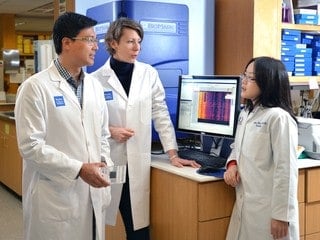A novel mechanism – similar to how normal tissue stem cells respond to wounding – might explain why bladder cancer stem cells actively contribute to chemo-resistance after multiple cycles of chemotherapy drug treatment. Targeting this “wound response” of cancer stem cells can potentially provide a novel approach for therapeutic invention, said researchers from the National Cancer Institute-designated Dan L. Duncan Cancer Center at Baylor College of Medicine.
The results of their study appear online in the journal Nature today.
“Treatment for advanced bladder cancer is limited to surgery and chemotherapy. There are no targeted treatments available,” said Dr. Keith Syson Chan, an assistant professor of molecular and cellular biology and of urology and the corresponding author on the report. “The chemotherapy response is far from ideal so the clinical goal is to advance research into this area and uncover a much more targeted approach.”
Together with co-lead authors Antonina Kurtova, a graduate student in the Translational Biology and Molecular Medicine Program at Baylor, and Dr. Jing Xiao, research assistant in urology at Baylor, Chan and his team sought out to identify mechanisms underlying the development of resistance in bladder cancer that has invaded the muscles. They found that regrowth of cancer stem cells actively contributes to therapy resistance between drug treatment cycles.
“This is a paradoxical mechanism leading to resistance, one we didn’t expect,” said Chan. “The cancer stem cells actively regrow and respond to the induced damage or apoptosis (cell death) caused by chemotherapy in between the different cycles, similar to how normal tissue stem cells respond to wound-induced damages.”
The proliferation is stimulated by the release of a metabolite (or factor) called prostaglandin E2 or PGE2 from the dying cells, which causes the cancer stem cells to repopulate tumors that were reduced in size by chemotherapy, they found.
In normal cells, this is a part of the wound repair process when PGE2 induces tissues stem cells to regrow; in cancer PGE2 ironically induces regrowth of more cancer stem cells in between chemotherapy cycles, Kurtova and Xiao said.
Chan said it is important to note that chemotherapy is administered in multiple cycles, which actually evokes the surprising finding.
“Chemotherapy is applied in one cycle then stopped to allow your bone marrow and normal stem cells to recover from the damage, and then another cycle starts again,” he said. “The cancer stem cells are also recovering during this gap period, induced by PGE2 released from dying cancer cells.”
“What would happen if you block PGE2?” the researchers asked.
In studies conducted in mice, the team found that blocking PGE2 abolished the induction of “wound-response” that fuels the regrowth of the cancer stem cells.
In one mouse experiment using tumors extracted from a human patient who previously failed chemotherapy, the team observed an enhanced therapeutic response.
“Importantly, we were able to use a drug already approved by the U.S. Food and Drug Administration,” said Kurtova. “This should help us quickly speed up time to start of human clinical trials.”
That drug was Celecoxib or Celebrex®, a drug most commonly used as a treatment for arthritis.
Further study in clinical trials is necessary, but the study provides a promising new find in a type of cancer with no current targeted options, Chan said. Importantly, this treatment may be applicable to other types of solid cancers, he said.
Additional authors on the report include Qianxing Mo; Senthil Pazhanisamy; Ross Krasnow; Seth P Lerner; Fengju Chen; Terrence Roh; Erica Lay and Philip Levy Ho, all of Baylor.
Funding for this work was supported by the National Cancer Institute (CA129640, CA175397): V Foundation for Cancer Research Scholar Award; Dan L. Duncan Career Award; Bladder Cancer Partnership; Cancer Prevention and Research Institute of Texas (RP101499, RP140102); American Urological Association Research Scholar Award (P.L.H.)
The work was also supported by the Genomic & RNA Profiling Core, Cytometry & Cell Sorting Core and Human Tissue Acquisition & Pathology Core at Baylor, and the Texas Advanced Computing Center at the University of Texas at Austin and Rice University resources.


